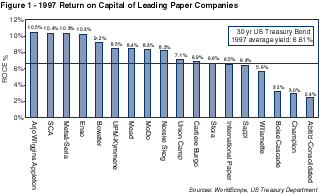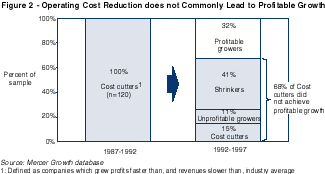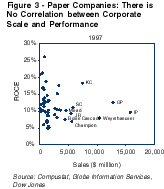|
How can asset-intensive companies break away from average performance and get off the cost/price reduction tread mill?
By Piers Whitehead, Nate Lentz, and Jamie Bonomo
Put your customers before your assets
The business environment for most asset-intensive industries is undeniably tough. Even before the Asian financial crisis led to substantial overcapacity and gave certain countries a devaluation-based advantage, the environment was characterized by intense competitive pressure and a lack of pricing power.
The value creation record of these industries fully reflects such pressures. In the past decade, these sectors have substantially underperformed stock market benchmark indices. This fact alone should be cause for concern, but two additional factors make their underperformance even more significant.
Firstly, the financial performance of asset-intensive firms is poor, not only in relative, but also in absolute terms. For example, 1997 was a tough, year for the paper industry, but not trough, yet only half of the world's leading paper companies produced returns on capital significantly in excess of the US long bond rate. Even fewer returned their true cost of capital (Figure 1).

Secondly, there are few, if any, companies in asset-intensive sectors that have convincingly and sustainably broken away from the pack. In the retail, airline or computing industries, the stock market increasingly values industry leaders disproportionately to other companies, leading to order-of-magnitude valuation differentials. This polarization has yet to emerge in most asset-intensive industries, suggesting that investors do not perceive that a current leadership position significantly enhances long-term earnings power.
Pessimistic observers might interpret this data as proof that leadership in asset-intensive industries is structurally unattainable or lacking in value. They argue that the characteristics of the industries and markets put constraints on the returns and degree of strategic control available to companies. For example, the maturity of demand growth, cyclicality of supply and (to a lesser extent) demand, growing customer power, and the unrelenting push of expensive and highly visible production assets all combine to reduce the potential for distinctive strategies.
These arguments are seductive and the reasoning is based on issues that represent real challenges to management teams. But a cynic might also suggest that it is convenient to blame underperformance on factors beyond management's control. Given both the growing efficiency of capital markets and increasing institutional shareholder activism, such a position is not tenable in the long term.
Bad industry
Research by Mercer Management Consulting (MMC) and other companies strongly supports the view that arguments based on the 'bad industry' theme are deceptive. In fact, growth opportunities exist everywhere and there are significant openings waiting to be grasped by forward-thinking managers. Added to that, many of the world's most admired value-creating companies have succeeded in mature markets. Examples include Coca Cola (beverages), General Electric (industrial equipment), Hennes & Mauritz (family fashions), and SMH (watches). In contrast, a 'hot' market hardly guarantees value creation. The personal computer industry is littered with companies which have failed to capture value despite the industry's rapid growth. The conclusion is that strategy, rather than industry participation, determines a firm's fortunes.
Four strategies are currently in play in most asset-intensive industries - ongoing operating cost cuts, asset scale, industry consolidation and portfolio reshaping. Unfortunately, past experience shows that none of these strategies is likely to create sustained value growth.
In competitive markets, companies need to find the lowest possible cost position that is consistent with their value proposition to remain on a healthy financial footing. It seems obvious that cost reduction will hit diminishing marginal return, or indeed begin to do positive harm. US industry is probably closest to this point, having been through a major round of downsizing and re-engineering in the early 1990s. The US experience illustrates that companies whose sole strategy is based on cost reduction will not succeed in creating value (Figure 2).

Asset scale is also a much less powerful cost lever than it once was, given that average plant sizes have risen substantially in recent decades. Despite this trend, asset-intensive companies continue to invest in ever-larger facilities. To make things worse, the advantage gained with each new generation of facilities is smaller than the previous generation of upgrades. In many sectors, this may now be reaching diminishing marginal returns.
A strategy relying on asset scale also brings a host of problems. For one thing, production assets lose any semblance of production flexibility at maximum scale. The owner of the latest generation super-plant is often forced to concentrate on the most standardized and high-volume segments of demand, to the exclusion of more financially attractive niches. Added to that, new facilities often represent an appreciable percentage of the market and certainly much of the market growth in the startup year. Given that the economic case for such investments is only valid (if at all) at high utilization levels, new capacity often has to buy its way into the market, with obvious implications for pricing.
A final flaw in asset scale as a competitive strategy is the ease with which it can be imitated. In most asset-intensive industries, producers have little or no proprietary process technology. As a result, today's super-plant is usually superseded by a competitor's latest investment, which incorporates all the enhancements of the previous plant, with that little extra on top.
Consolidation disappoints
In recent years, companies have opted for a third strategy - substantial industry consolidation through merger and acquisition activity. Chemicals, oil and paper have all seen a wave of major deals, with more to come.
Yet in fact, there is little evidence that corporate scale delivers higher returns in asset-intensive industries. This should not come as a surprise. The cost-based argument for larger corporations - namely that a high proportion of costs at the corporate level, such as R&D or brand advertising, are fixed - does not apply to most asset-intensive industries. This is not to say that consolidation yields no cost savings, but rather that these savings are not strategically compelling. They may be offset by some of the diseconomies of scale, including the difficulties of managing a larger and broader enterprise. Managers may find that after duplication has been eliminated and excess capacity closed, their business is structurally in no better a position than it was before the deal (Figure 3).

Another argument often heard in favor of consolidation is that markets are excessively fragmented, leading to intense competition and price volatility. Taken to its logical conclusion of monopoly, there must be some truth in this view. But at levels of concentration likely to prove acceptable to regulators, the evidence that higher concentration leads to higher returns is weak.
Conversations with industry leaders support the view that consolidation tends to cause disappointment. Customers react to the emergence of a dominant supplier by transferring some of their business elsewhere - two plus two makes rather less than four. Pricing power proves elusive, even with relatively high market shares.
One last point that further undermines M&A activity as a break-away strategy is the fact that the majority of deals fail to create value for the acquiring company. M&A seems seductive because it is rapid and high impact, and in managerial terms, easier to execute than the push to transform a company organically. It is difficult to make deals work in practice though, especially when the underlying rationale for value creation is weak.
A fourth, and more recent strategy in asset-intensive industries, has been the trend to radical portfolio reshaping. The logic for these moves appears to be that certain businesses are structurally superior to others. And secondly, that the success factors in the different businesses are sufficiently distinct that separate ownership and management need to be established in order for them to prosper.
There is a lack of analytical evidence to support the first point and, on the second point, a cautionary note must also be sounded. Taking General Electric as an example, the range of its activities does not appear to have held back the company's value creation performance. From a business unit strategy perspective, there is a more serious flaw. Unless the discontinued businesses are actually closed down, portfolio reshaping merely transfers the challenge of creating value in asset-intensive businesses to a different management team and set of shareholders.
Most of the current strategies (except for portfolio reshaping) focus mainly on cost reduction. Attention to cost and asset utilization continues to be important, but the ultimate beneficiaries of such strategies are not shareholders but customers. Most of the cost savings are typically passed on to them by way of price reductions. The main objective of a company's strategy should be to get off the treadmill of ongoing cost reductions continuously passed on to customers, but this will require significant strategic innovation.
Customer-in thinking
One of the solutions for asset-intensive companies lies in a better understanding of their markets, particularly on the customer and revenue side of the equation. It is possible to balance a customer-in strategy with the requirements of remaining cost competitive and keeping assets utilized. The logic of customer-in thinking is supported by two arguments. Firstly, focusing on the cost and asset side has mainly led to disappointing value growth results. Even where such efforts have yielded results, their future potential is limited. Added to that, MMC's research into the drivers of value growth indicates that the key to success lies in an understanding of customer priorities and a business design to serve them. As a result, the most effective way to develop strategy is to reverse the value chain and start with the customer.
By defining their customers' real priorities, a company can identify opportunities to capture value - those places where customers will allow a supplier to make profit. Only then should a company determine what is required to address that opportunity. This reversal of the value chain, to customer-in from asset or competency-out, also reverses much current strategic thinking, which holds that companies should stick to what they are good at. But what should a company do if customers attach no differential value to what it is good at?
The second argument in favor of customer-in thinking is that if a business remains static in its design it will inevitably fall victim to the migration of stock market value - either to businesses that are more focused on customers' shifting priorities or the customers themselves will capture all excess financial returns.
Lessons to learn
Asset-intensive firms commonly question the logic that understanding customer priorities is the critical first step in building robust strategies. Senior executives often see a largely homogeneous customer environment, where price is the sole or dominant purchasing criterion. Internally, low costs and high utilization rates are the focus of management attention. A major challenge lies in persuading such skeptics of the value of customer-in thinking.
On one end of the scale, there are examples of major companies that have adopted and implemented this thinking to their shareholders' benefit. At the other end, some smaller companies have also moved profitably to exploit the gaps between what major 'commodity' suppliers think it is worth supplying, and what some customers actually want and are willing to pay for.
Among the companies which have implemented these strategies, a few common characteristics have emerged:
• each company's strategy focuses on segmenting and targeting customers, based on an understanding of their needs and potential value to the supplier
• organization and business design is optimized to deliver on customers needs
• the driver of behavior is value and profit rather than share or volume.
• human capital has been at least as critical to success as physical assets
• the longer-lived examples show the importance of continuous innovation in business design.
In asset-intensive industries, the belief that customers only care about price stands in the way of absorbing these lessons. Indeed, sales and marketing efforts focus almost completely on negotiating prices and second-guessing the likely trend, frequently to the practical exclusion of all other considerations. MMC research found a broad range of customer profitability, much of it explained by price rather than cost-to-serve differentials. These price differentials were not attributable to customer purchasing power though. A price-only focus tends to grossly oversimplify the range of customers' needs. Price sensitivity is not uniform either. The wide range in prices paid in commoditized markets is based, not on customers' size or gullibility, but rather on the different needs of their businesses. An asset-intensive firm that actively understands and manages these different needs is a rare species.
Although asset-intensive companies may claim that price is all that matters in marketing terms, they rarely follow this reasoning through to its logical conclusion. If all a customer wants is product at the lowest possible price, why provide technical service, a direct sales force, brochures and brands, relationship-building events, and other traditional tools of business-to-business marketing? The answer is that certain customers value some of these things and are willing to pay for them, whereas others are not. Once a company has identified and understood which customers are which, it can put in place business designs targeted to different needs.
Entrepreneurs fill the gap
An important side-effect of the price focus among major players is the opportunity it creates for other, often smaller, companies to create value. Focusing solely on price creates a self-fulfilling prophecy, driving the increased commoditization which suppliers would prefer to avoid. A uniform set of customer needs simplifies a supplier's life, but it is unlikely to yield adequate financial returns. Meanwhile, customers will find other ways to meet their more complex needs.
For example, some demand segments for certain paper products in the USA are now primarily served through paper brokers, a trend that is beginning to appear in the UK and continental Europe. At any point in time, a paper broker's customers could probably buy some or all of their needs more cheaply on the open market, but they opt to pay a premium for a service. This is often because they have become frustrated with poor advice and unreliable supply from paper companies. From the paper companies' point of view, this trend is damaging in two ways. Firstly, the loss of direct customer contact removes a source of marketing insight and intelligence. Secondly, and more tangibly, the paper brokers are often able to negotiate low prices from utilization-hungry mills by aggregating volume from their customers.
Similar trends abound in other industries. There is growing involvement by financial intermediaries in many 'commodity' sectors, reflecting customer frustration with price volatility. Service-based intermediaries are also proliferating. Manufacturers may have the technological means, but lack the customer understanding and service mindset.
Building momentum
Breaking away from average performance and getting off the cost/price reduction treadmill is no easy task for asset-intensive industries. Managers willing to make the break should first ask themselves how likely superior performance really is under current plans and strategies. If the answer is not convincing, experience suggests that true and lasting performance improvement is unlikely and a radical shift in direction is required.
The management team must acknowledge that radical, not incremental, change is required, and that customer-in thinking should determine the shape of that change. Even after the new mindset is in place, putting customer-in thinking into practice is a difficult task. It involves figuring out where and why the firm makes or loses money today, where are the untapped sources of customer dissatisfaction, and what are the implications for the organization's business design.
Customer-in thinking will not deliver strategies that transform the company's prospects overnight. Moving from an asset-out to a customer-in strategy requires not just operational adjustments, but also shifts in culture, information systems, training and organizational structure. Once achieved though, a customer-in orientation will be deeply embedded in the organization. More importantly, it is hard to copy, and the lead gained on competitors can often be measured in years. Making this change represents the most promising road to sustained value growth for asset-intensive companies.
Piers Whitehead, Nate Lentz, and Jamie Bonomo, are vice presidents of Mercer Management Consulting based, respectively, in London, San Francisco and Pittsburgh
|